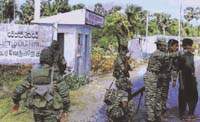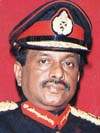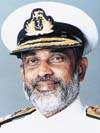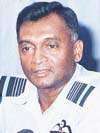 |
|||||||
|
The second stand-off
Questions over why Navy failed to act on second Tiger vessel May Day's incident off the seas of Batticaloa, where aval craft intercepted two fishing trawlers bringing ashore weapons for the Liberation Tigers of Tamil Eelam (LTTE), has laid bare another significant development. After the first trawler carrying the name "Duwa Mekhala," exploded when a Naval craft moved closer, the second fishing trawler loaded with mortar shells and rocket propelled grenades (RPGs) was successfully beached. It was in a stretch of no man's land, just two kilometres north of the Army detachment at Kadjuwatte, north of Batticaloa. A Naval patrol with Army escorts saw the military hardware laden fishing trawler, at close quarters. A near confrontation developed between the guerrillas and the Navy-Army group after the former had threatened to open fire if they interfered with the trawler.
Did the men withdraw because of this threat ? Were they ordered to do so or take the decision themselves ? Is their claim that their craft developed engine problems correct ? These are among questions to which answers are being sought by a top level inquiry now under way. It is headed by Rear Admiral Sarath Rathnakeerthi, Commander, Eastern Naval Area headquartered in Trincomalee. This week he recorded statements from sailors who were engaged in the patrol and is due to send a report with findings to Navy Headquarters. As reported in these columns (Situation Report - May 5), those on board one of the fishing trawlers blasted themselves. Contrary to some reports emanating from a far end of the globe, thousands of miles away from Sri Lanka, the Navy did not fire at the first fishing trawler in question. Nor was this trawler engaged in fishing. The Sunday Times has learnt fuller details of how the Naval craft tracked down the two fishing trawlers. Due to national security concerns, one cannot go into the finer points purely to counter diabolical claims that the Navy fired at fishing trawlers without any rhyme or reason. This is clearly part of a deliberate propaganda campaign to blame the Navy for the incidents and thus the Government for a ceasefire violation. The issue was grist to the mill for LTTE propagandists. However, other details of the incident, which have now emerged, throw further light on what happened. First to what the Army's 23 Division had to say on the incident: "Naval troops detected two suspicious fishing boats positioned three nautical miles east of Vakarai, which were proceeding towards the land. The fishing boats did not stop when challenged and on closing up for inspection one boat exploded itself at 1740 hours. In the meantime the second boat beached approximately six miles south of Vakarai. "The beached boat then started to move north towards Vakarai. At 1835 hours Naval troops detected another suspicious fishing boat positioned 4.5 nautical miles east of Vakarai. On closing up for inspection, the boathad fired at Naval boats. Several attempts were made to stop the boat, but failed. "In the meantime Naval troops retaliated in self defence resulting in the suspicious boat exploding and it remained ablaze for a long time. One Fast Attack Craft proceeded for a search operation of the area carrying two Sri Lanka Monitoring Mission personnel on board.During the clearing operation the under-mentioned items were recovered: 30 nos. 120 mm mortar bombs ,6 nos. 82 mm mortar bombs and 6 nos. Rocket Propelled Grenades" Navy officials say the mortar bombs and rocket propelled grenades were floating on a large piece of wreckage from the first fishing trawler that exploded. What of the second trawler which "beached approximately six miles south of Vakarai" ? This is where an Army Detachment at Mankerni, and another at Kadjuwatte, together with a Naval Sub Unit (NSU), went into action. The detachments come under the purview of the 232 Brigade functioning under the Army's 23 Division. A report from the 23 Division to Army Headquarters said that upon receiving intimation from Eastern Naval Area Headquarters, about the sighting of the two suspicious fishing trawlers off the shores between Mankerni and Kadjuwatte, ground troops located in both detachments were sent out. Those at Mankerni moved northwards whilst men at Kadjuwatte advanced southwards. The report said "Ground troops deployed at close proximity to Kadjuwatte coast reported that a suspected trawler is floating approximately 300 to 400 metres from the coast. Later, immediate arrangements were made to deploy the Naval Sub Unit with Army troops as escorts. By this time, it was further noticed that the suspected trawler commenced movement towards the north. Only one Naval craft was able to approach almost 25 metres to the suspected trawler. However, they had not adhered to instructions. Somebody inside had instructed not to stop the trawler. Troops have seen approximately four persons in the trawler in civil clothes." By then a loud explosion had already occurred. The mortars and RPGs on board exploded wrecking the fishing trawler. The NSU boat with Navy-Army men on board pursued the second trawler, which was approximately two kilometres off the shores where the Kadjuwatte Army Detachment was located. They are said to have arrived close to the beached second fishing trawler carrying military hardware. The 23 Division report revealed "Monitoring LTTE radio transmissions revealed that whilst this activity was going on, terrorist leader in 46 Base activated his cadres and instructed them to attack troops if they move towards north from Kadjuwatte…." Only Rear Admiral Rathnakeerthi's investigations will reveal fuller details of how the second fishing trawler, loaded with the military hardware, escaped from the shores near Kadjuwatte, whilst armed guerrilla cadres, who had arrived by boats, provided cover. It is now confirmed that this fishing trawler got away with the goods. How then did another boat explode ? A confrontation occurred between guerrilla boats which had arrived to secure the second fishing trawler and Naval boats which pursued it, but found it difficult to get closer to the shore in view of the shallow draught. Without a doubt, fishing boats which were in the vicinity were caught in the crossfire, though it is difficult to establish whether they were hit by guerrilla or Navy gunfire. The fact that fishermen were involved is confirmed by a report from the 23 Division Headquarters in Trincomalee. It said: "………information received that three boats belonging to civilians named M.T. Iliyar and Abubakkar Anwar that had gone fishing in general area Vakarai around 1830 hours on 01 May 2002 have not returned. Later around 1530 hours on 03 May 2002 the civilian named S.T. Iliyar had reported to the Army that he has been informed by the LTTE that two persons who were on board have been killed and another was injured due to a fire fight on 01 May 2002. eanwhile the other boat owner Abubakkar Anwer also had been informed by the LTTE that his boat too is in Vakarai area. Further, both boat owners had been asked to come with SLMM (Sri Lanka Monitoring Mission) representatives to take over the bodies, boats and equipment" The issue is
a closed matter as far as the Sri Lanka Monitoring Mission (SLMM)
is concerned. It has held that the incident did not lead to a ceasefire
violation. How does one prove the military hardware was smuggled
in by the guerrillas though it is as clear as daylight that it was
meant for them ? |
|||||||
|
Situation Report Archives
Copyright © 2001 Wijeya Newspapers
Ltd. All rights reserved. |
|||||||



